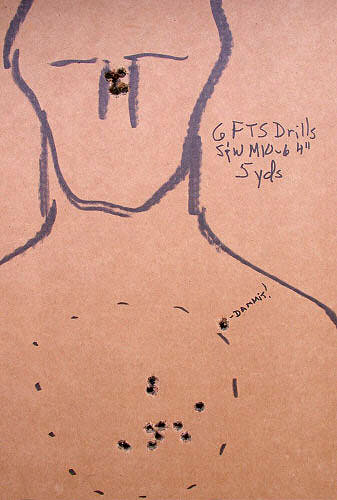
Shooting the S&W Model 10 in Defense
A while back I wrote an article suggesting that the K-frame .38 Special, specifically the Model 10 w/4" HB, could make a very viable home defense gun, range gun or "insurance policy" to take when camping and so forth. Not as easy to conceal as some smaller revolvers and autos, the 4" Smith & Wesson M10 can be carried concealed if push comes to shove and there's just no other choice.
For those interested, here is the link:
http://www.hipowersandhandguns.com/Humble%2038%20Special.htmShortly after this article was put up on the site, I received a rather insulting email from a gentleman stating that I had done the shooting public and "newbies" a disservice. (That's not the way he put it, but you get the idea.) Essentially, if the firearm being used for protection wasn't a "high-capacity" autoloader, the would-be defender was doomed to failure according to this fellow. He went on to suggest that I was opposed to private citizens having "high-capacity" firearms! That royally got my goat because it simply is not true. Were it up to me, all firearms (including suppressed, short-barreled rifles & shotguns as well as full-auto) could be owned by honest citizens and without jumping through all of the current "hoops". There would simply be stiff criminal penalties for those committing violent unlawful acts with any of them. In other words, we would each be responsible for our actions.
It occurred to me that "arguing" back and forth would serve little purpose so today, I took a very common S&W revolver to the range and ran it through its paces, so to speak. My choice was a used S&W Model 10-6 Heavy Barrel .38 Special revolver. It was wearing Eagle Secret Service grips and had a bobbed hammer with the single-action notch removed. Thus, it was a DAO firearm which I figured was appropriate as this is the manner in which the revolver would be used in a life-or-death situation…at least I think it would.
I mainly shoot for enjoyment and normally shoot boring old bullseye. Occasionally I practice what many call "practical shooting", i.e.: defensive shooting. I do not claim that either the time-limits mentioned or groups shot set any kind of benchmark for this sort of thing. It is just what I do. I leave it completely to the reader to set any merit or lack thereof to it as it might relate to his or her situation.
Ammunition: In today's session I used but one load and it was ammunition I reloaded at home. It clocks just shy of 900 ft/sec and is comparable in recoil to my preferred "carry load", Remington's 158-gr. LHP +P.
This handload was used:
158-gr. Redline CSWC
4.8-gr. ("Old") Unique
Winchester Small Pistol Primer
Once-fired Remington .38 Special Cases
Average Velocity: 894 ft/sec
My listing this reload does not constitute any recommendation to use it but I have never had a moment's trouble with it through several revolvers from a couple of different makers. It was used to save money while at the same time providing the recoil commensurate with an honest defense load, nothing more.
Distances & Shooting: Today's session did not involve any shooting at distances further than about 12 yards. All was done standing and with a two-hand hold. Draws were from a strong-side Fobus paddle holster and a PACT Club Timer III was used. Drawing began with the hands in the classic "IPSC Surrender Position". Drills starting with the gun in hand commenced from a low-ready position. Times shown include reaction times to the first shot. It felt a bit odd not shooting at 15 and perhaps 25 yards or further!
Drill 1: Higginbotham Standard Handgun Controllability Test: Mr. Jim Higginbotham had been a federal firearm instructor for many years and set one aspect of "handgun controllability" as being 5 shots into a folded 8 1/2 x 11" piece of paper at 5 yards in no more than 2 seconds. I didn't use a folded piece of paper but rather hand-drawn "man" targets with a 4 to 5" diameter circle located in the high chest. This drill was shot 6 times and the average time required was 1.88 seconds. One time through, I did let one get just outside the circle so I failed in that instance. This exercise started with the revolver in the low ready and not holstered.
Drill 2: Classic Failure to Stop Drill: This is the classic "Two to the body and one to the head" also known as the "Mozambique Drill". It is reported that a fellow trying desperately to that spot was armed with a Browning 9mm Hi Power and encountered an armed, threatening terrorist at an airport. He shot the dude twice in the chest but nothing desired seemed to happen. He then shot the terrorist though the brain, converting him to a good terrorist and did escape. I am neither advocating nor detracting from its relevancy as a defense drill. Some handgun instructors recommend it while others don't. You decide if you believe it to be relevant. The drill was done six times. Average time was 2.23 seconds.

This FTS drill was repeated 6 times for an average of 2.23 seconds. Distance was 5 yards. It took considerably longer than the Higginbotham Controllability Drill, which I believe is due to my more precisely aiming for the head shot.
Drill 3: Double-Action 12-Yd. Shooting: Though probably farther than the majority of deadly force scenarios the private citizen might face, I did fire at a bullseye-type target at this distance. The start was from the low ready position.
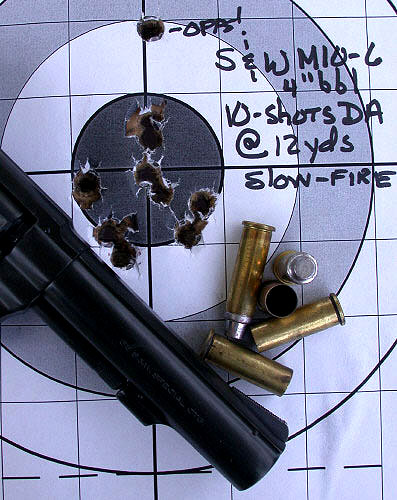
These groups were fired from "short parking lot" distances with no real effort at speed. I did let one get "out" on me and knew it when I did it. My fault and not the gun or ammunition! I threw this in because I still believe it is important to do some "precision" shooting to maintain the "hard wiring" for proper sight picture, and the other basics. Though not really pushing for speed, I did fire a bit faster than usual, but I flat forgot to time each group or individual shot.
Drill 4: Draw-and-Fire One shot: This exercise is simple what it says. Draw and fire a single shot into the circled high-chest "bullseye" on the "Gort" target.
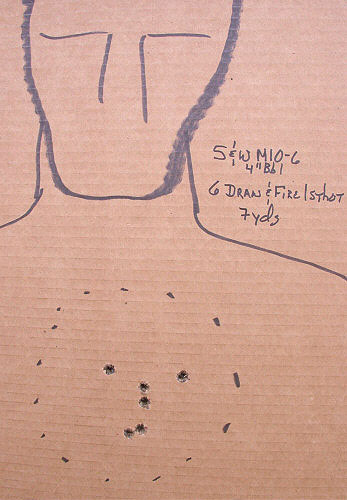
Like all of the previous exercises except for the 12-yard one, this drill was repeated six times. Average time was 1.4 seconds. This was done at 7 yards.
Drill 5: Draw-and-Fire Head Shots @ 4 yards: Like the previous exercise, this one started with hands up in classic IPSC Surrender Position. Distance was considerably shorter, only 12 ft. I used the same target I had used moments before when I drew and fired one shot to the chest. This time I used the head area.
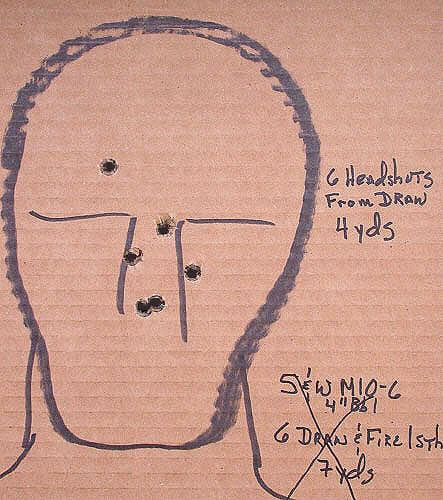
Like the other drills except for the bullseye target, this one was repeated six times. The average time per shot, including the draw was 1.25 seconds. The five on the nose would probably have solved the problem immediately. The one hit on the forehead might…or might not have. Now and then a bullet will follow the skull's rounded contours instead of penetrating.
Conclusion: First, the great speed-shooter, Mr. Jerry Miculek, has nothing to fear from me. I am nowhere near his coattail on shooting the revolver fast and accurate. He takes that to a much higher level of expertise than I'll ever achieve. At the same time, I do feel pretty confident that these times are respectable and doable by others; many can easily surpass them.
Shooting these same drills with either a tuned 1911 .45 auto or 9mm Hi Power generally result in a bit quicker times with roughly the same accuracy level. Thus, in a match using Comstock or other scoring method emphasizes time along with accuracy, my Model 10 shooting would rate lower than the automatic. In a real defense scenario, I believe that if the revolver shooter is "doomed to failure" as the email to me declared, it would for reasons other than the gun being "slow" or "obsolete." I read somewhere that "It is the singer and not the song"; to me, that still rings true.
The S&W Model 10 is certainly a "bare bones" six-gun but one that has a proven history for reliability. In years past, thousands upon thousands of these filled police holsters. Today, such is not the case but untold numbers of private citizens own these fine revolvers. Some want to use them as defense guns and others use them only for range fun.
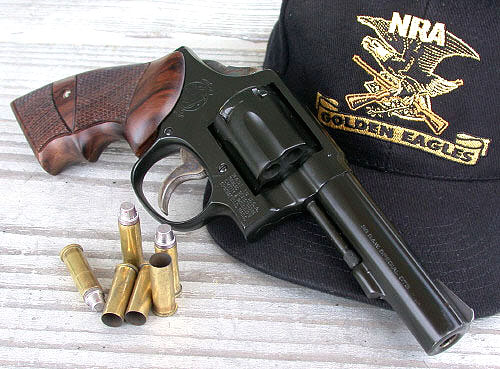
The Model10 square butt HB 4" revolver was chosen because these are widely owned revolvers. I believe that the "pencil bbl" version as well at other K-frames can also serve their users well.
I concede that the six-shot revolver absolutely is slower to reload than the autoloading pistol assuming equal training in such. To me this is an important factor to be sure. At the same time I think that the extended "firefight" is not so likely for the private citizen as for the SWAT officer or soldier. That does not mean that it couldn't happen! You decide which attributes the defensive handgun must have to be viable. I enjoy and shoot semiautomatic handguns quite a lot and believe that they are very viable protection tools. I feel the same way about quality double-action revolvers. I leave it to the reader to decide whether or not I did the shooting public a "disservice" in saying so.
Best.